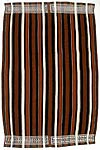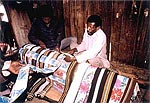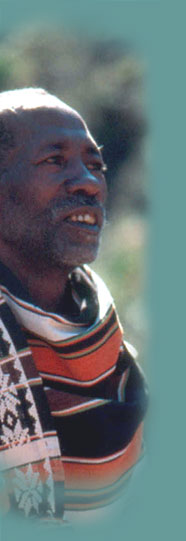
 The
importance of handwoven textiles in Madagascar is in large part related
to the connection made between cloth and ancestors. Cloth is considered
an ancestral object kept and handed down within families and a potent
symbol of authority, wealth, status and identity. Because of this, widespread
use of textiles in burial and reburial ceremonies continues throughout
Madagascar. Wrapping the deceased or the coffin in cloth demonstrates
respect for the dead, "clothing" them appropriately for their life in
the afterworld. In some areas, the remains of departed family members
are removed from tombs after many years and rewrapped in new cloth during
joyous reburial celebrations that emphasize strong ties between the living
and their deceased ancestors. The
importance of handwoven textiles in Madagascar is in large part related
to the connection made between cloth and ancestors. Cloth is considered
an ancestral object kept and handed down within families and a potent
symbol of authority, wealth, status and identity. Because of this, widespread
use of textiles in burial and reburial ceremonies continues throughout
Madagascar. Wrapping the deceased or the coffin in cloth demonstrates
respect for the dead, "clothing" them appropriately for their life in
the afterworld. In some areas, the remains of departed family members
are removed from tombs after many years and rewrapped in new cloth during
joyous reburial celebrations that emphasize strong ties between the living
and their deceased ancestors.
In some regions, handwoven cloth must be worn for particular events. In southeastern and western Madagascar, for example, leaders mark their sacred status during ceremonies in which they wear handwoven cloth as a wrapper over their other attire. During ceremonial events in the south, men of all ages continue to prefer handwoven loincloths as an instant sign of wealth, status and respect for local ancestral custom.

Great variety exists in Malagasy burial ceremonies, but throughout the island cloth plays a major role in all burials. In many regions, siblings, children, grandchildren and other relations are required to offer cloth to wrap or bury the body. By dressing the dead, descendants ensure the deceased's continued social existence in the next life. Elaborate funerary rites acknowledge ancestors and their mystical powers, which hold the key to the fortunes and misfortunes of the living. When pleased, ancestors bless the living with prosperity and fertility.

In Madagascar's highlands, Merina and northern Betsileo families periodically organize ceremonies called famadihana to replace the burial cloth of ancestors. Those whose shrouds have begun to disintegrate are said to appear to descendants in dreams to complain that they are cold. In reburial ceremonies, close relatives bring gifts of new silk cloth and food in a two-day event that culminates in the opening of the tomb and the removal of the skeletal remains. Once the remains are securely bound in new cloth, the participants dance joyfully with the newly enshrouded bundles as they convey them back to the tomb. Lightweight and durable synthetic fiber cloths are becoming acceptable substitutes for handwoven silk shrouds.

 For
the Tandroy peoples of Madagascar's south, a burial is a time for kin
to unite and demonstrate their family ties. In the days immediately following
a death, relatives and friends come from near and far to convey their
condolences and offer gifts of cloth. The night before the burial, the
coffin is decorated with all the cloth, which is folded into narrow lengths
and interlaced with colorful folds of commercial fabric. Literally clothed
in the affection of the descendants, the coffin bearing the deceased is
taken to an open area outside the village for an afternoon of spirited,
ritual dancing accompanied by music and song. At nightfall the coffin
is finally conveyed to the cemetery. For
the Tandroy peoples of Madagascar's south, a burial is a time for kin
to unite and demonstrate their family ties. In the days immediately following
a death, relatives and friends come from near and far to convey their
condolences and offer gifts of cloth. The night before the burial, the
coffin is decorated with all the cloth, which is folded into narrow lengths
and interlaced with colorful folds of commercial fabric. Literally clothed
in the affection of the descendants, the coffin bearing the deceased is
taken to an open area outside the village for an afternoon of spirited,
ritual dancing accompanied by music and song. At nightfall the coffin
is finally conveyed to the cemetery.
Pictured above (from top to bottom)
Tanala king wrapped in Betsileo cloth
Photograph by Wendy Walker, 1991
Great cloth (lambabe), sarimbo landy style
Betsileo peoples, Madagascar
2000
Silk, cotton, dye
National Museum of African Art, Smithsonian Institution, museum purchase, 2000-13-11
Silk "great cloths" are woven for family use--for men for official oratory, for a bride or groom, and to shield the coffin of deceased elders.
For this Tandroy funeral rite, the coffin is decorated with folded lengths of locally woven and commercially printed textiles.
Photograph by Sarah Fee, Ambondro, 1994
|
